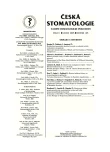Titanium Disc Modified with Hydroxyapatite and Zirconia Does not Reveal Signs of Cytotoxicity
Authors:
Z. Teuberová 1; M. Seydlová 1; T. Dostálová 1; M. Jelínek 2; B. Dvořánková 3
Authors‘ workplace:
Stomatologická klinika 1. LF UK a VFN Praha
přednosta prof. MUDr. J. Mazánek, DrSc.
1; Fyzikální ústav AV ČR, Praha
ředitel Ing. K. Jungwirth, DrSc.
2; Klinika popáleninové medicíny 3. LF UK Praha
přednosta MUDr. L. Brož
3
Published in:
Česká stomatologie / Praktické zubní lékařství, ročník 105, 2005, 1, s. 7-11
Category:
Overview
The paper deals primarily with the study of biological properties of a model of implant covered with a thin layer of hydroxyapatite with an intermediate layer of zirconium. Cytotoxicity was evaluated by direct cultivation with mouse and human fibroblasts. A physical test using X-ray diffraction confirmed that the film is composed of crystalline hydroxyapatite. The evaluation of the cytotoxicity test and a comparison with controlled samples cultured in parallel in vitro made it possible to conclude that the material is not cytotoxic audit is suitable for further experiments in more detail.
Key words:
implant – hydroxyapatite – zirconium – X-ray diffraction – direct cytotoxicity test
Labels
Maxillofacial surgery Orthodontics Dental medicineArticle was published in
Czech Dental Journal

2005 Issue 1
Most read in this issue
- Corrosion Resistance of Titanium in Dentistry Applications
- Evaluation of the Effect of Propriosensitive Re-education Exercise in the Therapy of Temporomandibular Disorders
- Bonded Amalgam Filling – Part II: Clinical Evaluation after 7, 8 and 9 Years
- Molecular Genetic Identity of Blood and Oral Isolates of Viridans Streptococci
